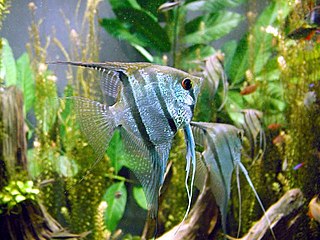
Cichlids are fish from the family Cichlidae in the order Cichliformes. Cichlids were traditionally classed in a suborder, the Labroidei, along with the wrasses (Labridae), in the order Perciformes, but molecular studies have contradicted this grouping. The closest living relative of cichlids is probably the convict blenny, and both families are classified in the 5th edition of Fishes of the World as the two families in the Cichliformes, part of the subseries Ovalentaria. This family is both large and diverse. At least 1,650 species have been scientifically described, making it one of the largest vertebrate families. New species are discovered annually, and many species remain undescribed. The actual number of species is therefore unknown, with estimates varying between 2,000 and 3,000.
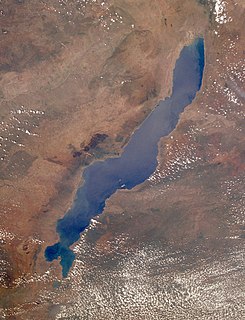
Lake Malawi, also known as Lake Nyasa in Tanzania and Lago Niassa in Mozambique, is an African Great Lake and the southernmost lake in the East African Rift system, located between Malawi, Mozambique and Tanzania.
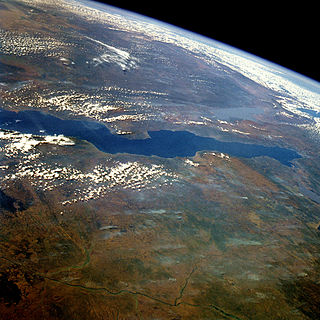
Lake Tanganyika is an African Great Lake. It is the second-oldest freshwater lake in the world, the second-largest by volume, and the second-deepest, in all cases after Lake Baikal in Siberia. It is the world's longest freshwater lake. The lake is shared between four countries—Tanzania, the Democratic Republic of the Congo (DRC), Burundi, and Zambia, with Tanzania (46%) and DRC (40%) possessing the majority of the lake. It drains into the Congo River system and ultimately into the Atlantic Ocean.

The African Great Lakes are a series of lakes constituting the part of the Rift Valley lakes in and around the East African Rift. They include Lake Victoria, the second-largest fresh water lake in the world by area, Lake Tanganyika, the world's second-largest freshwater lake by volume and depth, and Lake Malawi, the world's eighth-largest fresh water lake by area. Collectively, they contain 31,000 km3 of water, which is more than either Lake Baikal or the North American Great Lakes. This total constitutes about 25% of the planet's unfrozen surface fresh water. The large rift lakes of Africa are the ancient home of great biodiversity, and 10% of the world's fish species live in this region.
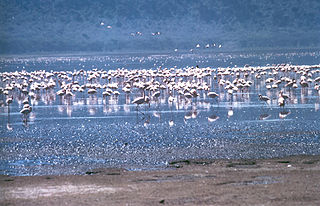
The Rift Valley lakes are a series of lakes in the East African Rift valley that runs through eastern Africa from Ethiopia in the north to Malawi in the south, and includes the African Great Lakes in the south. These include some of the world's oldest lakes, deepest lakes, largest lakes by area, and largest lakes by volume. Many are freshwater ecoregions of great biodiversity, while others are alkaline "soda lakes" supporting highly specialised organisms.

Lake Ohrid is a lake which straddles the mountainous border between the southwestern part of North Macedonia and eastern Albania. It is one of Europe's deepest and oldest lakes, with a unique aquatic ecosystem of worldwide importance, with more than 200 endemic species.

Lake Rukwa is an endorheic lake located the Rukwa Valley of Rukwa Region, Songwe Region and Katavi Region in southwestern Tanzania. The lake is the third largest in land body of water in the country.

The terms shell dwellers or shelldwellers, shell-breeding, or ostracophil are descriptive terms for cichlid fish that use the empty shells of aquatic snails as sites for breeding and shelter. The terms have no taxonomic basis, although most shell-dwelling cichlids are from Lake Tanganyikas lamprologine lineage. Many shell dwelling cichlids are popular with fishkeepings and are frequently kept in aquaria.
Community aquaria are tanks that are designed to contain more than one species of fish. Most commonly they include a variety of species that do not normally occur together in nature, for example angelfish from Brazil, swordtails from Mexico, and gouramis from South East Asia. The aim of such communities is to bring together fish that are compatible in temperament and water requirements, while using their different colours and behaviors to add interest and entertainment value.
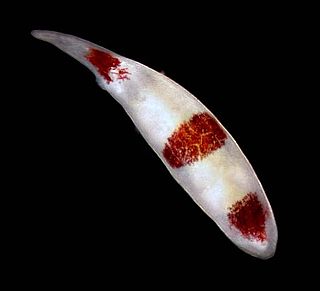
The Prolecithophora are an order consisting of an estimated 300 species of small, active, aquatic flatworms. The order lacks a common English name. Most species are shaped like an elongated, stylized droplet, and are opaque white or yellow; they frequently have contrasting bands or spots in colors, such as purple, yellow, red, or brown. They have no to three pairs of pigment-cup eyes, and well-developed tactile and chemoreceptor senses. With few exceptions, species are protandric hermaphrodites with internal fertilization. Egg capsules are, according to species, glued to various hard surfaces; the young hatch as miniature copies of their parents.

Lake Skadar – also called Lake Shkodër,Lake Shkodra or Lake Scutari – lies on the border of Albania and Montenegro, and is the largest lake in Southern Europe. It is named after the city of Shkodër in northern Albania. It is a karst lake.
Melanoides polymorpha is a species of freshwater snail with a gill and an operculum, an aquatic gastropod mollusk in the family Thiaridae.
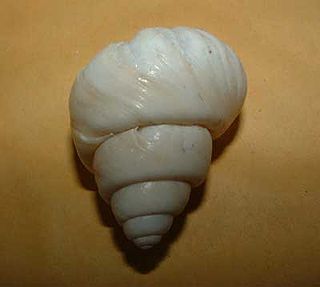
Neothauma is a genus of freshwater snail with a gill and an operculum, an aquatic gastropod mollusc in the subfamily Bellamyinae of the family Viviparidae.
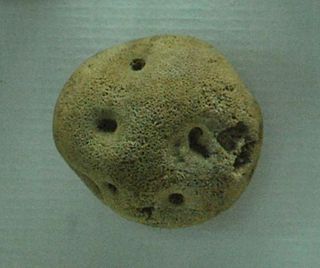
Ochridaspongia rotunda is freshwater sponge endemic to Lake Ohrid. This sponge is found mostly at depths of 30–50 m and water temperatures of 6–8 °C. Its circular shape indicates the animal lives under conditions of relatively calm water.

Ochridaspongia is genus of freshwater sponges containing two species:

Potamolepidae is a family of freshwater sponges, with seven genera:

Lubomirskiidae is a family of freshwater sponges from Lake Baikal in Russia.
Ohridohauffenia minuta is a species of minute freshwater hydrobiid gastropod, endemic to springs near Lake Ohrid. The species was originally found in the springs of Studenicista in North Macedonia. Road construction extirpated the only known population, as surveys in 2009 failed to find the species in this site which is also the type locality. The endemic springs were of freshwater, and had stony bottoms with a constant temperature of 11 °C.














